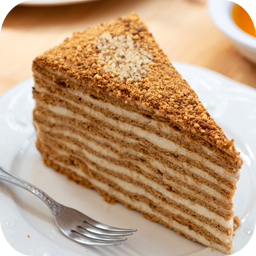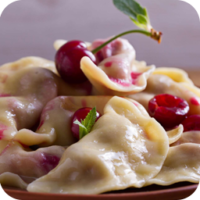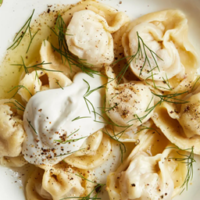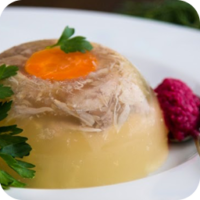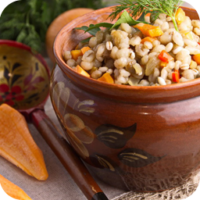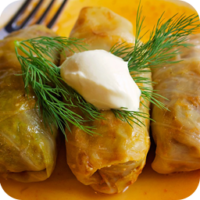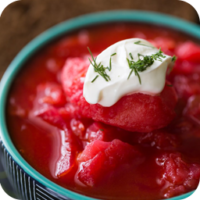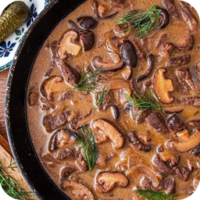Medovik (Медовик) is a traditional Russian honey cake known for its rich, sweet flavor and soft, layered texture. It is a beloved dessert in Russian cuisine and is often served at celebrations, holidays, and special occasions. The cake is made with honey, flour, eggs, and sugar, and is layered with a creamy filling, typically made from sour cream or condensed milk and butter. The combination of honey, caramelization, and smooth cream filling creates a delightful balance of sweet, tangy, and creamy flavors.
Key Ingredients:
- Honey:
- The most essential ingredient in Medovik is honey, which gives the cake its distinct sweet and slightly floral flavor. It also contributes to the moistness of the cake layers.
- Dough:
- The dough is made from flour, eggs, sugar, baking soda, and honey. The honey is often combined with the baking soda, which causes it to caramelize and gives the cake a slightly darker color.
- Cream Filling:
- The traditional cream filling is made from sour cream and sweetened condensed milk, creating a tangy, creamy texture. Sometimes, butter is added to enrich the filling, and it is often flavored with a splash of vanilla.
- Decoration:
- Medovik is usually decorated with crumbled cake crumbs, which are sprinkled on top and around the sides to create a rustic, textured finish.
Flavor Profile:
- The flavor of Medovik is sweet and rich, with the honey providing a distinct, mellow sweetness. The cake layers have a slightly caramelized flavor due to the honey and baking soda reaction. The cream filling adds a tangy, smooth, and slightly rich taste, balancing the sweetness of the cake itself.
How It’s Made:
- Prepare the Cake Layers:
- First, honey is combined with sugar and baking soda in a saucepan and heated until the mixture is smooth and slightly caramelized. This mixture is then combined with eggs and flour, forming a soft dough.
- Roll and Bake the Layers:
- The dough is divided into several small portions, which are rolled out into thin circles. These circles are then baked at a moderate temperature until golden brown.
- Prepare the Cream Filling:
- While the cake layers are baking, the cream filling is made by whisking together sour cream and condensed milk (sometimes with added butter for richness) until smooth and well-combined.
- Assemble the Cake:
- Once the cake layers have cooled, they are stacked and layered with the cream filling. The layers are built up one at a time, spreading a generous amount of the creamy filling between each layer.
- Decorate the Cake:
- The top layer of the cake is usually decorated with crumbled pieces of the extra baked cake layers, giving the cake its characteristic appearance. Some people also decorate the sides or top with additional cream.
- Chill and Serve:
- Medovik is best served after it has been chilled in the refrigerator for several hours or even overnight. This allows the cake to soften and the flavors to meld together.
Cultural Significance:
- Medovik is a celebration cake in Russian culture, often made for weddings, birthdays, New Year’s, and other special occasions. It is considered a symbol of warmth, family gatherings, and festivity. The honey used in the cake is also seen as a symbol of health and good fortune in Russian folklore.
- The cake’s origins can be traced back to the 19th century, though it became widespread in Russia after the Soviet era and is now one of the most recognized traditional Russian cakes.
Variations:
- Cream Filling Variations:
- Some variations use whipped cream, mascarpone, or a mix of sweetened condensed milk and butter for the filling instead of sour cream.
- Additional Flavors:
- Some versions of Medovik include additional flavors such as vanilla, cinnamon, or lemon zest in the cream or the cake layers to enhance the flavor profile.
- Decorative Additions:
- Besides crumbled cake crumbs, Medovik can be decorated with chopped nuts, chocolate shavings, or dried fruits for added texture and visual appeal.
Health Benefits:
- Honey is the primary sweetener in Medovik, which provides antioxidants and is believed to have anti-inflammatory properties. However, because the cake is rich in sugar, butter, and cream, it is quite indulgent and should be eaten in moderation.
Serving Tips:
- Medovik is best served after it has been refrigerated for a few hours to allow the cake layers to soften and the flavors to meld together. It is typically sliced into small pieces, as it is rich and filling.
- It pairs well with black tea or coffee for a satisfying dessert or afternoon snack.

